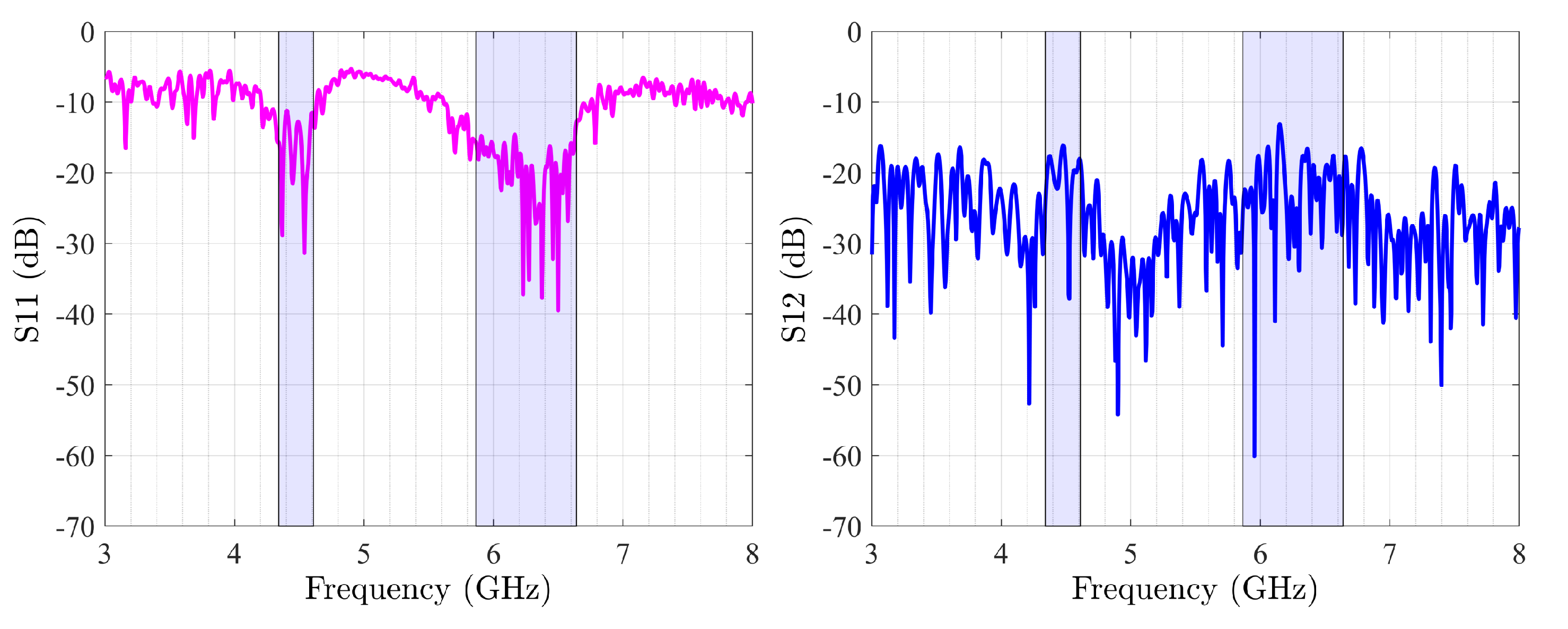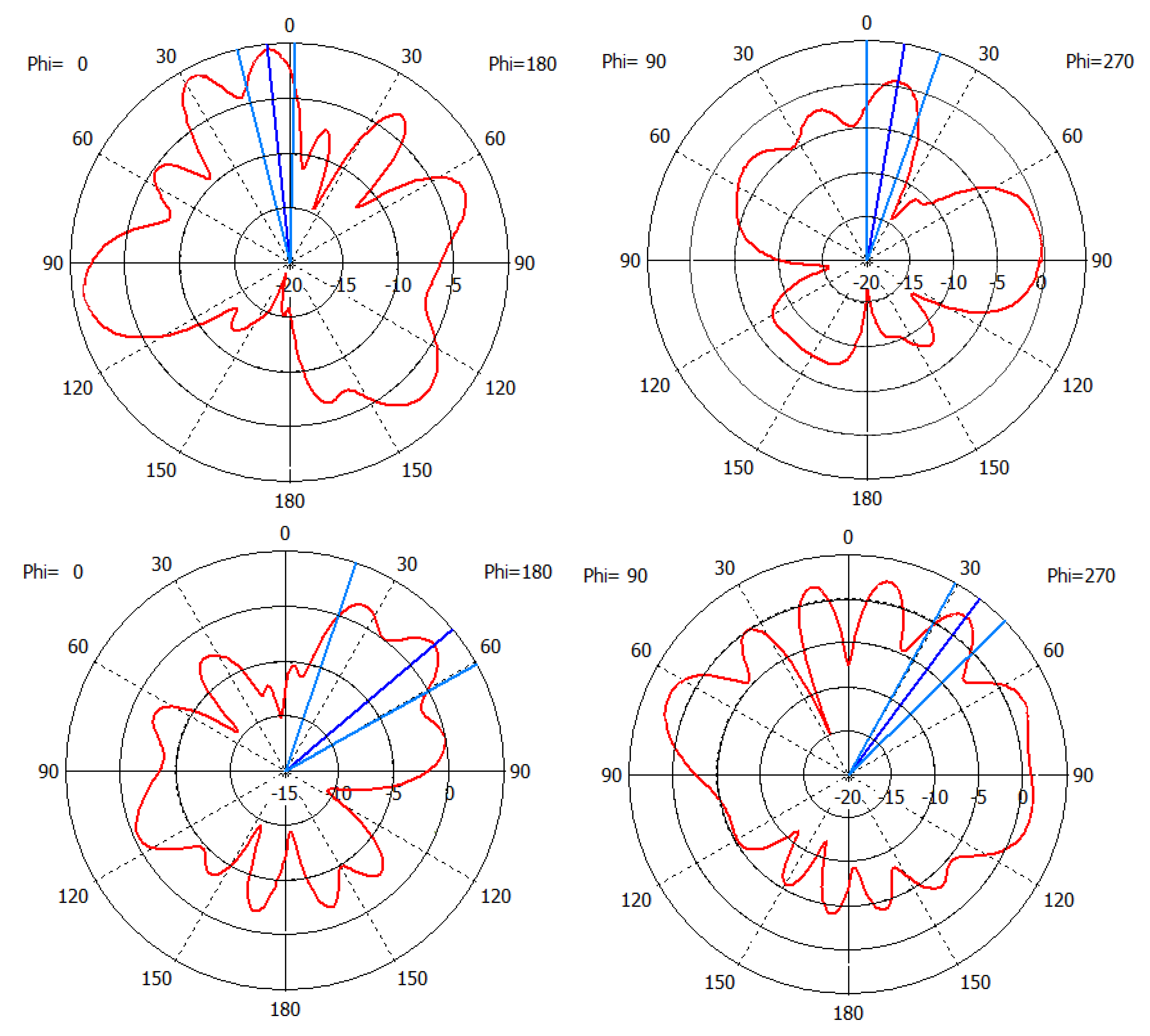Deep Learning Assisted Automatic Methodology for Implanted MIMO Antenna Designs on Large Ground Plane
Abstract
:1. Introduction
2. Proposed Optimization Method
| Algorithm 1: Automatic methodology for optimizing implanted MIMO antennas using sequential TDO and DNN methods |
Phase I (TDO method) 1: Define the biological tissues and define the dielectric properties of each tissue; 2: Mount all the tissues over together with the sequence of bone, liquid, and plexiglass; 3: Design the MIMO antenna on the substrate and ground planes; Phase II (DNN method) 4: Determine the design parameters and specifications of the MIMO configuration; 5: Run parametric sweep for achieving the training and testing dataset for constructing DNN; 6: Achieve the optimal hyperparameters of the hidden layer using the BO method; 7: Train the LSTM-based regression DNN; 8: Predict the optimal design parameters by using the trained DNN. |
2.1. Top-Down Optimization for Configuring the Implanted MIMO Antenna
2.2. Regression DNN for Sizing the Design Parameters of Implanted MIMO Antenna
3. Practical Implementation of the Optimization-Oriented Method
4. Simulation Results of the Optimized Implanted MIMO Antenna
5. Conclusions
Author Contributions
Funding
Conflicts of Interest
References
- Ahmed, I.; Halder, S.; Bykov, A.; Popov, A.; Meglinski, I.V.; Katz, M. In-Body Communications Exploiting Light: A Proof-of-Concept Study Using Ex Vivo Tissue Samples. IEEE Access 2020, 8, 190378–190389. [Google Scholar] [CrossRef]
- Magill, M.K.; Conway, G.A.; Scanlon, W.G. Circularly Polarized Dual-Mode Wearable Implant Repeater Antenna With Enhanced Into-Body Gain. IEEE Trans. Antennas Propag. 2020, 68, 3515–3524. [Google Scholar] [CrossRef] [Green Version]
- Soliman, M.M.; Chowdhury, M.E.H.; Khandakar, A.; Islam, M.T.; Qiblawey, Y.; Musharavati, F.; Zal Nezhad, E. Review on Medical Implantable Antenna Technology and Imminent Research Challenges. Sensors 2021, 21, 3163. [Google Scholar] [CrossRef] [PubMed]
- Usman, M.; Kobal, E.; Nasir, J.; Zhu, Y.; Yu, C.; Zhu, A. Compact SIW Fed Dual-Port Single Element Annular Slot MIMO Antenna for 5G mmWave Applications. IEEE Access 2021, 9, 91995–92002. [Google Scholar] [CrossRef]
- Mendoza, H.A.; Corral-Briones, G. A Three Dimensional MIMO Channel Model for Unmanned Aerial Vehicle in Urban Environments. IEEE Open J. Commun. Soc. 2021, 2, 1419–1430. [Google Scholar] [CrossRef]
- Budhu, J.; Rahmat-Samii, Y. A Novel and Systematic Approach to Inhomogeneous Dielectric Lens Design Based on Curved Ray Geometrical Optics and Particle Swarm Optimization. IEEE Trans. Antennas Propag. 2019, 67, 3657–3669. [Google Scholar] [CrossRef]
- Jarufe, C.; Rodriguez, R.; Tapia, V.; Astudillo, P.; Monasterio, D.; Molina, R.; Mena, F.P.; Reyes, N.; Bronfman, L. Optimized Corrugated Tapered Slot Antenna for mm-Wave Applications. IEEE Trans. Antennas Propag. 2018, 66, 1227–1235. [Google Scholar] [CrossRef]
- Zhu, D.Z.; Gregory, M.D.; Werner, P.L.; Werner, D.H. Fabrication and Characterization of Multiband Polarization Independent 3-D-Printed Frequency Selective Structures With UltraWide Fields of View. IEEE Trans. Antennas Propag. 2018, 66, 6096–6105. [Google Scholar] [CrossRef]
- Rajo-Iglesias, E.; Quevedo-Teruel, Ó.; Inclan-Sanchez, L. Mutual Coupling Reduction in Patch Antenna Arrays by Using a Planar EBG Structure and a Multilayer Dielectric Substrate. IEEE Trans. Antennas Propag. 2008, 56, 1648–1655. [Google Scholar] [CrossRef]
- Liang, S.; Fang, Z.; Sun, G.; Liu, Y.; Qu, G.; Zhang, Y. Sidelobe Reductions of Antenna Arrays via an Improved Chicken Swarm Optimization Approach. IEEE Access 2020, 8, 37664–37683. [Google Scholar] [CrossRef]
- Zhang, F.; Jia, W.; Yao, M. Linear Aperiodic Array Synthesis Using Differential Evolution Algorithm. IEEE Antennas Wirel. Propag. Lett. 2013, 12, 797–800. [Google Scholar] [CrossRef]
- Han, Q.; Zhang, Y.; Yang, Z.; Long, W.; Liang, Z. Antenna Array Aperture Resource Management of Opportunistic Array Radar for Multiple Target Tracking. IEEE Access 2020, 8, 228357–228368. [Google Scholar] [CrossRef]
- Mir, F.; Kouhalvandi, L.; Matekovits, L.; Gunes, E.O. Automated optimization for broadband flat-gain antenna designs with artificial neural network. IET Microwav. Antennas Propag. 2021, 15, 1537–1544. [Google Scholar] [CrossRef]
- Gao, D.; Guo, Q.; Eldar, Y.C. Massive MIMO as an Extreme Learning Machine. IEEE Trans. Veh. Technol. 2021, 70, 1046–1050. [Google Scholar] [CrossRef]
- Gragnaniello, D.; Bottino, A.; Cumani, S.; Kim, W. Special Issue on Advances in Deep Learning. Appl. Sci. 2020, 10, 3172. [Google Scholar] [CrossRef]
- Jin, J.; Zhang, C.; Feng, F.; Na, W.; Ma, J.; Zhang, Q. Deep Neural Network Technique for High-Dimensional Microwave Modeling and Applications to Parameter Extraction of Microwave Filters. IEEE Trans. Microw. Theory Tech. 2019, 67, 4140–4155. [Google Scholar] [CrossRef]
- Supalov, A.; Semin, A.; Klemm, M.; Dahnken, C. Top-Down Software Optimization. In Optimizing HPC Applications with Intel® Cluster Tools; Apress: Berkeley, CA, USA, 2014; pp. 39–53. [Google Scholar] [CrossRef] [Green Version]
- Chae, S.h.; Kawk, W.i.; Park, S.O.; Lee, K. Analysis of mutual coupling in MIMO antenna array by TARC calculation. In Proceedings of the 2006 Asia-Pacific Microwave Conference, Yokohama, Japan, 12–15 December 2006; pp. 2090–2093. [Google Scholar] [CrossRef]
- Greenhill, S.; Rana, S.; Gupta, S.; Vellanki, P.; Venkatesh, S. Bayesian Optimization for Adaptive Experimental Design: A Review. IEEE Access 2020, 8, 13937–13948. [Google Scholar] [CrossRef]
- Mckay, M.; Beckman, R.; Conover, W. A Comparison of Three Methods for Selecting Values of Input Variables in the Analysis of Output From a Computer Code. Technometrics 1979, 21, 239–245. [Google Scholar] [CrossRef]
- Calculation of the Dielectric Properties of Body Tissues. Available online: http://niremf.ifac.cnr.it/tissprop/htmlclie/htmlclie.php. (accessed on 4 July 2021).
- Kanda, M.; Ballen, M.; Chou, C.K.; Balzano, Q. Formulation and Characterization of Tissue Simulating Liquids Used for SAR Measurement (500–2000 MHz) (invited). In Proceedings of the 2001 Asia-Pacific Radio Science Conference, Tokyo, Japan, 1–4 August 2001; p. 274. [Google Scholar]
- Matekovits, L.; Huang, J.; Peter, I.; Esselle, K.P. Mutual Coupling Reduction Between Implanted Microstrip Antennas on a Cylindrical Bio-Metallic Ground Plane. IEEE Access 2017, 5, 8804–8811. [Google Scholar] [CrossRef]
- Matekovits, L. On the radiation mechanism of implanted antennas with large conformal ground plane. IET Microwav. Antennas Propag. 2017, 11, 1765–1769. [Google Scholar] [CrossRef]






| Design Parameters | Value | Design Parameters | Value |
|---|---|---|---|
| (mm) | 22 | (mm) | 12.86 |
| (mm) | 3.47 | (mm) | 17.91 |
| (mm) | 3 | (mm) | 4.94 |
| (mm) | 4 | (mm) | 1 |
| (mm) | 13 | (mm) | 5 |
| (mm) | 3.5 | (mm) | 6 |
| (mm) | 1.5 | (mm) | 150 |
| (mm) | 120 | 11.2 | |
| 11.38 | 52.7 | ||
| 3.4 | (mm) | 0.035 |
Publisher’s Note: MDPI stays neutral with regard to jurisdictional claims in published maps and institutional affiliations. |
© 2021 by the authors. Licensee MDPI, Basel, Switzerland. This article is an open access article distributed under the terms and conditions of the Creative Commons Attribution (CC BY) license (https://creativecommons.org/licenses/by/4.0/).
Share and Cite
Kouhalvandi, L.; Matekovits, L.; Peter, I. Deep Learning Assisted Automatic Methodology for Implanted MIMO Antenna Designs on Large Ground Plane. Electronics 2022, 11, 47. https://doi.org/10.3390/electronics11010047
Kouhalvandi L, Matekovits L, Peter I. Deep Learning Assisted Automatic Methodology for Implanted MIMO Antenna Designs on Large Ground Plane. Electronics. 2022; 11(1):47. https://doi.org/10.3390/electronics11010047
Chicago/Turabian StyleKouhalvandi, Lida, Ladislau Matekovits, and Ildiko Peter. 2022. "Deep Learning Assisted Automatic Methodology for Implanted MIMO Antenna Designs on Large Ground Plane" Electronics 11, no. 1: 47. https://doi.org/10.3390/electronics11010047







